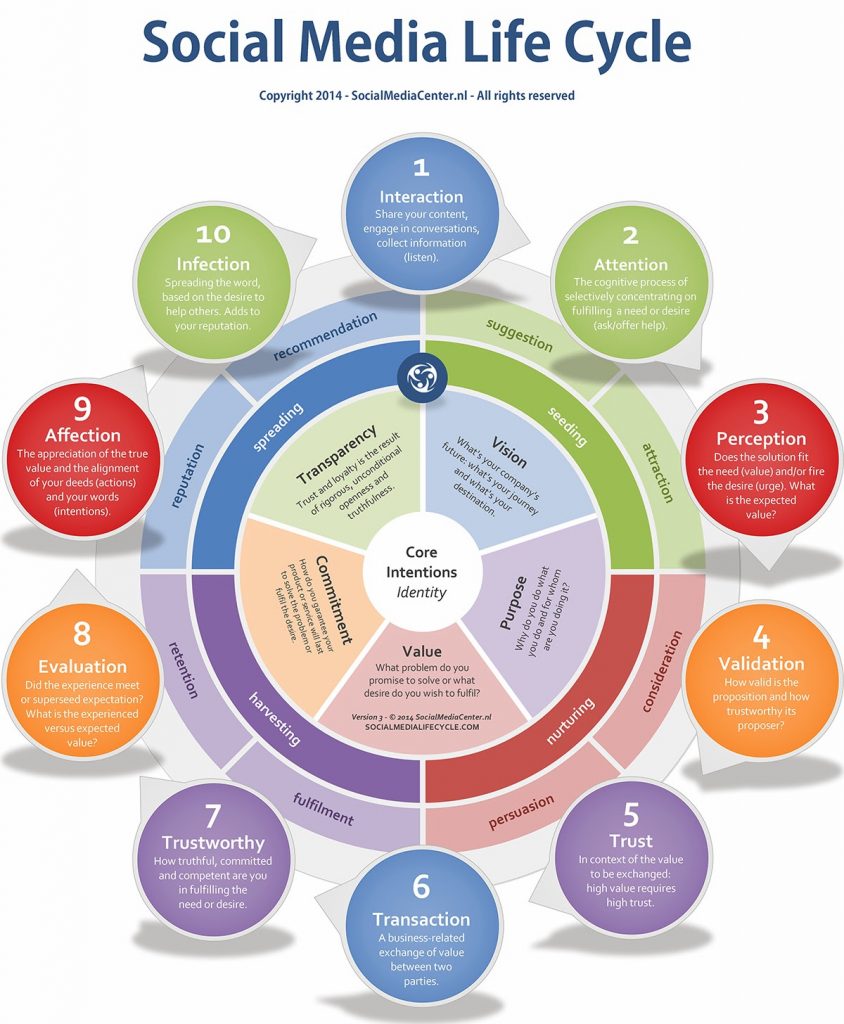
by Jeremy Abram
Every social platform begins with a promise — connection, creativity, community — but each one eventually reshapes not just how we interact online, but how we think, behave, and even perceive ourselves. The lifecycle of social media platforms isn’t just about technology; it’s about the psychology of attention and the adaptability (or exhaustion) of human behavior.
The Rise: Novelty and Network Effects
When a new platform enters the cultural bloodstream — think TikTok’s algorithmic discovery, or Instagram’s early focus on aesthetic storytelling — users are drawn by novelty. Early adopters feel a mix of excitement and opportunity: a chance to redefine how they express identity, gain visibility, or build influence.
The first stage of any social platform’s rise is marked by creative experimentation. The affordances of the medium — short videos, filters, reactions, ephemeral posts — invite behaviors that feel authentic and spontaneous. The algorithms reward exploration, and users’ dopamine systems reward the feedback loops of likes, shares, and comments.
From a UX and analytics perspective, engagement metrics at this stage are broad but shallow: time-on-platform is high, but intent is diffuse. The goal isn’t productivity — it’s discovery. People are mapping the emotional terrain of a new social environment.
The Evolution: Optimization and Saturation
As platforms mature, the energy shifts from creativity to optimization. Influencers learn the rhythms of the algorithm. Brands arrive with budgets. UX teams tweak interfaces to maximize dwell time and minimize friction.
The network effect — “everyone is here, so I should be too” — becomes the gravitational force keeping users engaged. But this also introduces behavioral rigidity. Once a platform optimizes for certain kinds of engagement (e.g., video completion rate, retention, ad clickthrough), users adapt their content and behavior to fit those incentives.
This is when analytics begins to distort culture: people learn to perform for the algorithm, not for each other. Metrics that once measured creativity now shape it.
In UX research, we see this in heatmaps and retention funnels — behavior narrows as users follow the most efficient paths to visibility. The interface, the metrics, and the culture start to mirror each other.
The Decline: Fatigue and Migration
Every dominant platform eventually faces attention fatigue. Users begin to sense the repetition: the same content formats, the same monetization schemes, the same psychological hooks.
When network effects collapse, it’s rarely dramatic — it’s gradual erosion. A few key influencers migrate to new spaces; niche communities fragment into subcultures on emerging platforms. Users don’t delete accounts — they just stop caring.
The UX signals are subtle: session durations shorten, scroll depth decreases, notifications go ignored. What’s happening isn’t rejection — it’s habituation. The brain adapts, and the novelty that once hooked users now feels like noise.
For analytics teams, this is when dashboards start to mislead: retention rates look stable, but meaningful engagement (comments, shares, time spent creating) quietly declines. The numbers say “steady,” but the culture says “over it.”
The Morphing Stage: Reinvention and Recontextualization
Some platforms refuse to die — they morph. Instagram pivoted from photos to Reels. X (formerly Twitter) is attempting to reinvent as an “everything app.” Even Facebook’s feed is now a hybrid of Reels, Marketplace, and memories.
But morphing isn’t always rebirth. Each change requires users to relearn the interface, the norms, and the unspoken rules of attention. The most adaptive users — and brands — are those who can navigate this constant recontextualization.
From a UX design standpoint, these moments of reinvention are high-stakes: too much change alienates loyal users; too little change makes the platform obsolete. Analytics becomes not just a measure of success but a map of behavioral resilience — how fast people re-adapt when the familiar turns foreign.
Behavioral Ripples: What Shifting Platforms Teach Us
Each platform transition leaves behind behavioral residue. TikTok taught users to process information in micro-bursts. Instagram trained us to equate aesthetics with authenticity. Twitter taught us to think in public — and to argue at scale.
As users migrate, these habits persist, creating what UX researchers call cross-platform behavioral transfer. The way we consume stories on Instagram informs how we watch TikToks. The way we comment on Threads feels like a shadow of our old Twitter habits. The platform changes, but the cognitive schema — how we expect attention to work — remains.
This is the hidden continuity in the chaos: while platforms evolve, human attention patterns iterate, not reset.
Analytics, Attention, and the Human Loop
For designers, strategists, and analysts, the lesson is clear: every metric is a fossil of human behavior — but not necessarily of human meaning. Engagement data tells us what people do, not why they do it.
When a platform rises, our behavior stretches to meet it. When it declines, we contract to protect our attention. The UX challenge is to design with empathy for that cycle — to anticipate the moment when novelty becomes noise, and when connection turns into compulsion.
Social media platforms will keep evolving. Our attention will keep adapting. The question isn’t whether we’ll follow the next app; it’s how consciously we’ll choose to engage when we get there.
Jeremy Abram
jeremyabram.net
Leave a Reply